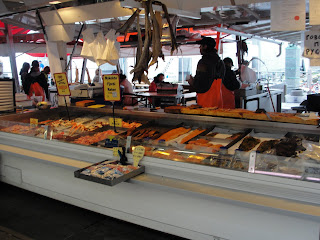The living room of our "apartment" at Las Clementinas in Casco Antigua (the old city).

The skyline of the New City from the balcony of the apartment. Note to self.......it is a good idea to check and see if there is an elevator in the building. Good thing we are still in good health! Four floors ain't as easy as it once was.


 The exterior of Hotel Las Clementinas. Our room is at the rear of the top floor. A pleasant restaurant on the main floor with a killer "House Martini."
The exterior of Hotel Las Clementinas. Our room is at the rear of the top floor. A pleasant restaurant on the main floor with a killer "House Martini." and right around the corner is the contrasting housing shown in the next photo, but not nearly so extreme as much we saw. Our hotel owners have established a project for training women of the community to work in entry level jobs in hotels and have so far placed 160 people in various locations.

A


The fish market on the waterfront is a source of great pride to most of the people here. Each day the fish are brought in and there is a warren of shops selling the catch of the day. In addition you can eat at sidewalk cafes where ceviche is the speciality, or you can go (as we did) upstairs to the restaurant and have fish and/or seafood that is ready prepared or purchased from the ground floor and cooked to order.


 These young men were taking the outboard motors off after a day's work, then carrying them up to cars or trucks on the wharf. Then the boats are paddled out (see the photo below) by a person who anchors the boat and then swims to shore.
These young men were taking the outboard motors off after a day's work, then carrying them up to cars or trucks on the wharf. Then the boats are paddled out (see the photo below) by a person who anchors the boat and then swims to shore.
 Some of the "molas" created by local women (or, mostly, the women of San Blas) and then brought to Panama City to sell. They are intricate reverse applique done with nearly invisible hand stitching.
Some of the "molas" created by local women (or, mostly, the women of San Blas) and then brought to Panama City to sell. They are intricate reverse applique done with nearly invisible hand stitching. 
One of the more unusual buildings in Panama's New City















